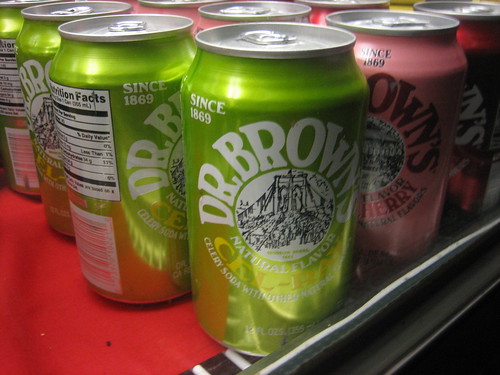Alley Kat
Active Member
http://torontoist.com/2009/04/kensington_markets_migratory_art_ga.php
Kensington Market's Migratory Art Gallery
Faye Mullen led us into the smaller of the two rooms that together make up minnow & bass gallery, a self-described "migratory" art space she opened on March 20 on the southern fringe of Kensington Market, at the eastern corner of the intersection of Dundas Street and Augusta Avenue.
She offered us the tiny space's one and only rickety wooden chair and sat contentedly on the floor (still paint-spattered from the recent renovation), smiling. She seemed almost to relax into these smiles, as if happiness were simply her natural state. Most people would have had a hard time striking this kind of perfect repose while sitting on hard concrete in front of a total stranger in a place that, until a few weeks ago, was a vacant storefront. Faye, meanwhile, didn't seem to be having any difficulty. To be fair, she'd just had plenty of practice.
When we spoke to her this past Sunday, Faye, a sculptress and performance artist, had recently finished living in her still-bare gallery non-stop for a full week as part of her OCAD thesis project, titled the extermities, of the series all or nothing: when I grow up. She watched strangers pass by the shop's windows, and they in turn watched her. Why did she do it? "To know what it's like to be a gallery," she said. "To know its moods."
It couldn't have been easy. Minnow & bass is not the type of plush, hermetically sealed place where fine art ordinarily goes to live (okay, so they're not all perfectly sealed). In fact, from a distance, it doesn't really look like much of anything at all. It's just a few square feet of commercial space on the borderline between Chinatown and Kensington Market, on a two-month lease. After those two months are up, so is the gallery's stay in its current location.
"That's the type of work I do," said Faye. "It's sort of ephemeral. You can't revisit it in the same way again."
Kensington Market is a neighbourhood that knows a lot about ephemerality. The 1999 conversion of the former George Brown College buildings on Baldwin Street into condos might be the single biggest change still fresh in the neighbourhood's collective memory, but a walk through the Market in April 2009 makes it obvious that the transformation is ongoing. The produce stores and bric-a-brac shacks that dominate the heart of Kensington are beginning to die of old age, and they're steadily being replaced by a new breed of business. (This was most evident during the great Starbucks scare of '08.) There are "for lease" signs all up and down Augusta Avenue. There's even one in the window of minnow & bass, the ultimate signal of its temporary status.
Faye, like so many other business owners in the area, has one foot out the door. The difference is that this was always her intention. She needed an affordable gallery space in which to stage her thesis, and two months was the absolute shortest lease the storefront's owner would allow.
"This hopefully won't be the last," Faye told us, when we asked her if the gallery would move to another place at the expiration of its lease. Where will minnow & bass go next? "Different parts of the city," said Faye. "Different storefronts that need help."
The storefront at Dundas and Augusta was in need of help. A year and a half ago it was a little corner shop called MILK STORE (it was capitalized like that on the sign). You wouldn't have wanted to buy any actual milk from MILK STORE. At least not without checking the expiration date first. When MILK STORE's dubious dairy and dusty chewing gum–based business model finally proved not to be a viable one, MILK STORE shuttered up for good. It was replaced, shortly afterward, by DJ's Clothing Store, whose owners made the questionable decision to paint the entire interior of the place the color of grimy traffic cones. They went out of business late last year.
The store sat empty for a few months. During that time, some graffiti artist, either incredibly hopeful or with an incredible sense of irony, wrote the word "patience" in orange letters below one of the shop's south-facing windows. In March, patience was rewarded: that's when Faye stepped in.
On the day we visited minnow & bass, the gallery's next art installation was underway. Irene Loughlin (pictured), another performance artist, was busy pulling found items (from her mother's Hamilton basement) out of a bag and arranging them strategically throughout the space, in preparation for a day-long piece dealing with notions of diaspora. The dirty-traffic-cone walls were gone. Faye and her helpers had rolled over all of it with eggshell white. "Everything was done really poorly when it was worked on," she told us.
Seeing how bright and beautiful the space had become and how much interest it was bringing to the corner (Irene, in a green dress, had begun step dancing in piles of black soil, while passers-by stopped at the windows to gawk), it was beginning to feel difficult to relinquish minnow & bass. We were starting not to want to see it go. Not an ideal state of mind for Kensington Market, where only the "for lease" signs stay the same.
minnow & bass gallery will continue to operate in its current location (594 Dundas Street West) until May 11, 2009. Until then, it's open from Thursday to Sunday, 12 to 7(ish). This week's installations are Rain by Tim Doiron and Strangers and Duets, a curated, photo-based show. See the gallery's Facebook group ("minnow & bass") for details on possible future locations.
Kensington Market's Migratory Art Gallery
Faye Mullen led us into the smaller of the two rooms that together make up minnow & bass gallery, a self-described "migratory" art space she opened on March 20 on the southern fringe of Kensington Market, at the eastern corner of the intersection of Dundas Street and Augusta Avenue.
She offered us the tiny space's one and only rickety wooden chair and sat contentedly on the floor (still paint-spattered from the recent renovation), smiling. She seemed almost to relax into these smiles, as if happiness were simply her natural state. Most people would have had a hard time striking this kind of perfect repose while sitting on hard concrete in front of a total stranger in a place that, until a few weeks ago, was a vacant storefront. Faye, meanwhile, didn't seem to be having any difficulty. To be fair, she'd just had plenty of practice.
When we spoke to her this past Sunday, Faye, a sculptress and performance artist, had recently finished living in her still-bare gallery non-stop for a full week as part of her OCAD thesis project, titled the extermities, of the series all or nothing: when I grow up. She watched strangers pass by the shop's windows, and they in turn watched her. Why did she do it? "To know what it's like to be a gallery," she said. "To know its moods."
It couldn't have been easy. Minnow & bass is not the type of plush, hermetically sealed place where fine art ordinarily goes to live (okay, so they're not all perfectly sealed). In fact, from a distance, it doesn't really look like much of anything at all. It's just a few square feet of commercial space on the borderline between Chinatown and Kensington Market, on a two-month lease. After those two months are up, so is the gallery's stay in its current location.
"That's the type of work I do," said Faye. "It's sort of ephemeral. You can't revisit it in the same way again."
Kensington Market is a neighbourhood that knows a lot about ephemerality. The 1999 conversion of the former George Brown College buildings on Baldwin Street into condos might be the single biggest change still fresh in the neighbourhood's collective memory, but a walk through the Market in April 2009 makes it obvious that the transformation is ongoing. The produce stores and bric-a-brac shacks that dominate the heart of Kensington are beginning to die of old age, and they're steadily being replaced by a new breed of business. (This was most evident during the great Starbucks scare of '08.) There are "for lease" signs all up and down Augusta Avenue. There's even one in the window of minnow & bass, the ultimate signal of its temporary status.
Faye, like so many other business owners in the area, has one foot out the door. The difference is that this was always her intention. She needed an affordable gallery space in which to stage her thesis, and two months was the absolute shortest lease the storefront's owner would allow.
"This hopefully won't be the last," Faye told us, when we asked her if the gallery would move to another place at the expiration of its lease. Where will minnow & bass go next? "Different parts of the city," said Faye. "Different storefronts that need help."
The storefront at Dundas and Augusta was in need of help. A year and a half ago it was a little corner shop called MILK STORE (it was capitalized like that on the sign). You wouldn't have wanted to buy any actual milk from MILK STORE. At least not without checking the expiration date first. When MILK STORE's dubious dairy and dusty chewing gum–based business model finally proved not to be a viable one, MILK STORE shuttered up for good. It was replaced, shortly afterward, by DJ's Clothing Store, whose owners made the questionable decision to paint the entire interior of the place the color of grimy traffic cones. They went out of business late last year.
The store sat empty for a few months. During that time, some graffiti artist, either incredibly hopeful or with an incredible sense of irony, wrote the word "patience" in orange letters below one of the shop's south-facing windows. In March, patience was rewarded: that's when Faye stepped in.
On the day we visited minnow & bass, the gallery's next art installation was underway. Irene Loughlin (pictured), another performance artist, was busy pulling found items (from her mother's Hamilton basement) out of a bag and arranging them strategically throughout the space, in preparation for a day-long piece dealing with notions of diaspora. The dirty-traffic-cone walls were gone. Faye and her helpers had rolled over all of it with eggshell white. "Everything was done really poorly when it was worked on," she told us.
Seeing how bright and beautiful the space had become and how much interest it was bringing to the corner (Irene, in a green dress, had begun step dancing in piles of black soil, while passers-by stopped at the windows to gawk), it was beginning to feel difficult to relinquish minnow & bass. We were starting not to want to see it go. Not an ideal state of mind for Kensington Market, where only the "for lease" signs stay the same.
minnow & bass gallery will continue to operate in its current location (594 Dundas Street West) until May 11, 2009. Until then, it's open from Thursday to Sunday, 12 to 7(ish). This week's installations are Rain by Tim Doiron and Strangers and Duets, a curated, photo-based show. See the gallery's Facebook group ("minnow & bass") for details on possible future locations.







